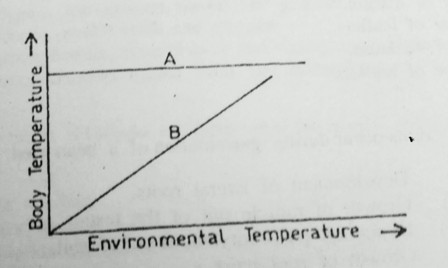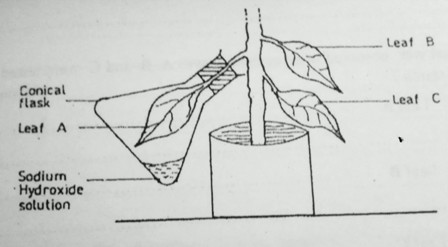PAPER 1
THEORY
SECTION A
Attempt all questions in this section by writing in the box provided, the letter representing the most correct answer.
1. Which of the following are structural adaptations to flight in birds?
A. Light bones and webbed feet.
B. Webbed feet and light feathers.
C. Streamlined body and light bones.
D. Smooth body and light feathers.
2. In which one of the following associations do both organisms benefit?
A. Malarial parasite and human.
B. Tapeworm and human.
C. A fungal parasite and plant.
D. Nitrogen fixing bacteria and leguminous plant.
3. Which one of the following methods would be the best for estimating the population density of rats in a bush?
A. Direct counting.
B. Quadrate method.
C. Line transects.
D. Capture - recapture method.
4. Addition of humus to a sandy soil would
A. Decrease the capillarity of the soil.
B. Increase the aeration of the soil.
C. Decrease mineral content of the soil.
D. Improve the water retention capacity of the soil.
5. At which of the following levels of classification can organisms interbreed and produce fertile offspring?
A. Class
B. Species
C. Phylum
D. Kingdom
6. By which one of the following processes does carbon dioxide leave the blood capillary into the alveoli?
A. Osmosis.
B. Active transport.
C. Diffusion.
D. Capillarity.
7. Which one of the following parts of the mammalian ear is concerned with balance?
A. Cochlea.
B. Semi circular canal
C. Eustachian tube.
D. Oval window.
8. The main reason why birds sit on their eggs during the incubation period is to ensure that
A. Hatching occurs quickly
B. Rain does not destroy eggs.
C. Eggs are kept at a constant temperature.
D. All eggs develop chicks at the same time.
9. Which one of the following would be a correct sequence of plant succession on an abandoned tarmac road?
A. Mosses - herbs - shrubs - trees.
B. Herbs - mosses - shrubs - trees.
C. Shrubs - herbs - trees - mosses.
D. Mosses - herbs - trees - shrubs.
10. Which one of the following is likely to cause pollution in water bodies?
A. Over fishing.
B. Boat racing.
C. Use of fertilizers.
D. Use of farmyard manure.
11. When a growing shoot is placed horizontally, it bends upwards after sometime. Which of the following best explains this response?
A. Which auxin concentration on the upper side inhibits growth on the upper side.
B. High auxin concentration on the lower side makes the lower side grow faster.
C. Lack of auxin on the upper side inhibits growth on the upper side.
D. Low auxin concentration on the lower side makes the lower side grow faster.
12. Which one of the following is an advantage of vegetative propagation?
A. Competition between parent and offspring is minimal.
B. Colonization of new habitats is fat.
C. Variation among offspring occurs.
D. Maintenance of parental characteristics in offspring.
13. Which one of the following excretory products are removed from the body by the kidney?
A. Urea, excess water and excess salts.
B. Urea, excess water and carbon dioxide.
C. Carbon dioxide, excess water and excess salts.
D. Carbon dioxide, urea and excess salts.
14. Which one of the following pairs of organs is important in the digestion of fats?
A. Stomach and liver.
B. Pancreas and stomach.
C. Liver and pancreas.
D. Stomach and mouth.
15. Which of the following describes the carrying capacity of a population?
A. Maximum number of organisms that can reproduce freely in a habitat.
B. Area occupied by organisms of different species.
C. Maximum number of organisms that can be supported by a specific area.
D. Maximum number of plants that can support animals in a given area.
16. Fig.1 shows how the body temperatures of animals A and B vary with environment temperature.

Which one of the following is demonstrated in the figure?
A. Body temperature of A is dependent on environmental temperature.
B. Body temperature of B is dependent on environmental temperature.
C. A has a higher body temperature than B.
D. B loses more than heat than A.
17. Which of the following features show continuous variation?
A. A. B and O blood groups.
B. Sickle cells.
C. Hemophilia.
D. Height.
18. Which one of the following is a likely effect of a decrease in the number of platelets in the blood?
A. The blood may not be able to carry enough oxygen.
B. There may be prolonged bleeding in case of an injury.
C. The body may not be able to fight disease.
D. The body may not be able to distribute heat efficiently.
19. Which one of the following characteristics may be used to determine whether leaves are compound?
A. Nature of margin.
B. Number of leaflets.
C. Type of venation.
D. Presence of leaflets.
20. The following events occur during germination of a bean seed.
(i) Development of lateral roots.
(ii) Growth of radical out of the testa.
(iii) Hypocotyls pull cotyledons out of soil.
(iv) Growth of roots hairs.
Which of the following gives the correct sequence of the events?
A. (i), (ii), (iii) and (iv)
B. (ii), (iii) (iv) and (i)
C. (ii), (iv) (i) and (iii)
D. (ii), (i), (iii) and (iv)
21. Which one of the following stimulates the reabsorption of water in the kidneys?
A. Adrenaline.
B. Antidiuretic hormone.
C. Thyroxin.
D. Insulin
22. The best explanation for panting of an athlete immediately after a race is to
A. Allow fast blood flow to the lungs.
B. Restore the used up energy.
C. Take in more oxygen.
D. Allow fast blood from the muscles.
23. During pregnancy in humans, the substances that pass from the mother to the embryo are
A. Oxygen, nitrogenous wastes and glucose.
B. Glucose, amino acids and oxygen.
C. Carbon dioxide, mineral salts and nitrogenous wastes.
D. Carbon dioxide, amino acids and mineral salts.
24. An endosperm is formed in plants when the second male nucleus fuses with the
A. Egg nucleus.
B. Polar nuclei.
C. Antipodal nuclei.
D. Embryo sac.
25. In pea plants, tallness is dominant over shortness. If a heterozygous tall plant is crossed with a short plant, the proportion of the offspring will be
A. 50 % tall, 50 % short.
B. 100 % tall
C. 25 % tall, 75 % short.
D. 75 % tall, 25 % short.
26. A farmer grew beans and noticed that the leaves turned yellow but the veins remained green. The minerals likely to be deficient in the soil are
A. Magnesium and iron.
B. Potassium and manganese.
C. Calcium and potassium.
D. Zinc and calcium.
27. Which of the following conditions increase the rate of transpiration?
A. High temperatures, windy conditions and high humidity.
B. Low temperatures, windy conditions and high humidity.
C. High temperatures, low humidity and windy conditioned.
D. Low temperatures, low humidity and still air.
28. Which of the following parts of a microscope magnify the object?
A. Eye piece and mirror.
B. Objective lens and mirror.
C. Eye piece and objective lens.
D. Eye piece and fine adjustment.
29. Which one of the following shows the correct order of cell organization?
A. Organism - system - organ.
B. Tissue - organ - organism.
C. Organ - tissue - organism.
D. Tissue - organ - system.
30. Which one of the following is a long term adaptation of mammals to low temperature environment?
A. Rising of hair.
B. Increase in metabolic rate.
C. Deposition of fats under the skin.
D. Reduction of blood flow to the skin.
SECTION B
Answer all questions in this section. Answers must be written in the spaces provided.
31. The table below shows the percentage composition of inhaled and exhaled air, in a human being at rest and also the composition of exhaled air, during exercise. Use the information in the table to answer the questions that follow.
| Inhaled air at rest | Water vapour | Nitrogen | Carbon dioxide | Oxygen |
| Variable |
79 % |
0.03 % |
20.96 % | |
| Exhaled air at rest | 0.8 % | 79 % | 4.1 % | 16.2 % |
| Exhaled air during excersise | 0.92 % | 79 % | 4.5 % | 15.58 % |
a) State the differences in composition between inhaled and exhaled air at rest.
b) Give a reason for each differences stated in (a).
c) State the changes that occur in the composition of exhaled air in a human being who is previously at rest, then takes an exercise.
d) Give a reason why each change stated in (c) occurs.
e) During exercise, the breathing rate increases. From the information provided, suggest why this happens.
f) Why is the percentage of nitrogen constant and exhaled air?
32. To investigate the effect of carbon dioxide on photosynthesis, a green plant was destarched by leaving it in darkness for 24 hours. After destarching, leaf A was put in a conical flask as shown in figure 2 while leaf B was immediately tested for starch. The set up was then left in light for 12 hours after which leaves A and C were tested for starch.

a) Why was sodium hydroxide used in the experiment?
b) State two reasons why when the plant was placed in darkness for 24 hours it became destarched.
c) State the purpose of including each of leaves B and C in the experiment.
(i) Leaf B .....................................................................................................
(ii) Leaf C .....................................................................................................
d) What was observed when each of leaves A, B and C were tested for starch?
(i) Leaf A ..................................................................................................
(ii) Leaf B ..................................................................................................
(iii) Leaf C ................................................................................................
e) Give reasons why each of the following is carried out while testing a leaf for starch.
(i) Put a leaf in boiling water.
(ii) Put a leaf in hot ethanol.
33. a) What do you understand by a recessive gene?
b) A man who is a carrier for albinism married a normal woman. Using suitable symbols, work out the proportions of the possible genotypes and phenotypes of their children.
c) Give two benefits of studying human genetics.
SECTION C
Answer any two questions.
34. a) Explain the value of earthworms in maintain the soil in a condition suitable for crop growth.
b) How does clay affect the fertility of soil?
35. a) What are functions of a skeleton in mammals?
b) With the aid of a labelled diagram, describe how movement is caused in a named hinge joint in a mammal.
36. a) What factors are necessary for germination in seeds?
b) Using labelled diagrams, describe experiments to show the necessity of each factor for germination.
37. In humans, the blood circulatory and lymphatic systems transport body fluids.
a) Outline the functions of the lymphatic system.
b) Explain the changes that occur in the composition of blood as it passes through the capillary of the following parts of the body.
(i) Lungs
(ii) Liver
(iii) Kidneys.
